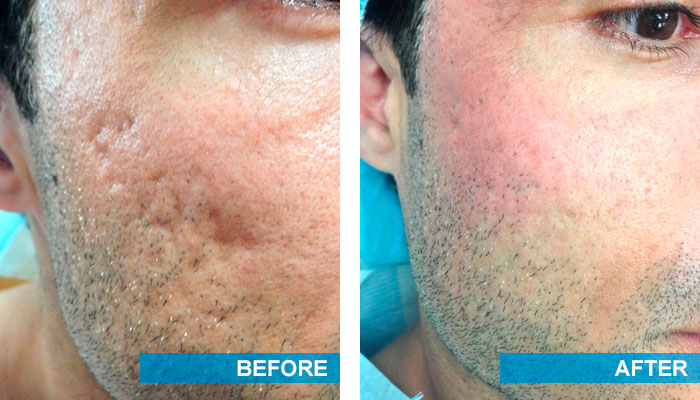Checking Out Skin Problem: Dealing With and determining Acne Scars for Healthier Skin
Acne scars stand for a significant problem for individuals looking for to keep healthy skin, as they can influence both appearance and self-esteem. Comprehending the different types of scars, from atrophic to hypertrophic, is essential for establishing proper treatment alternatives.
Recognizing Acne Scars

The body's natural healing procedure can lead to either atrophic scars, which appear as depressions in the skin, or hypertrophic scars, which are increased and arise from overproduction of collagen. Additionally, the emotional toll of acne marks must not be ignored; lots of individuals report sensations of shame, anxiousness, and reduced self-worth. This psychological concern can influence social interactions and overall top quality of life.
Addressing acne marks requires a comprehensive understanding of their formation and effect. Awareness of the potential for long-term repercussions associated with untreated scars can motivate individuals to look for proper therapies. Early treatment and reliable management approaches can considerably enhance skin look and enhance emotional strength, emphasizing the importance of understanding the intricacies bordering acne scars.
Types of Acne Marks
Acne marks can be categorized right into unique types, each displaying special qualities and calling for certain therapy strategies. acne treatment for sensitive skin. The main kinds of acne scars consist of atrophic, hypertrophic, and keloid scars

Hypertrophic scars, on the other hand, are raised over the skin level and are the result of excessive collagen manufacturing throughout the healing procedure. They normally stay within the limits of the original acne lesion. Keloid scars are comparable however extend past the initial injury site, creating bigger, increased areas that can be itchy or uncomfortable.
Comprehending these sorts of marks is essential for selecting appropriate treatment choices. Various marks may react much better to particular treatments, such as laser treatments, fillers, or medical interventions, emphasizing the significance of a customized technique to acne scar administration.
Determining Your Scars
Acne scars normally fall into 2 classifications: hypertrophic and atrophic scars. These can additionally be categorized into ice-pick scars, boxcar marks, and rolling marks, each displaying distinct attributes and calling for different methods for assessment.
Hypertrophic marks, on the various other hand, are increased and take place due to extreme collagen production during the recovery procedure. Acknowledging the certain attributes of your scars-- such as structure, deepness, and width-- is essential for correct identification (acne treatment for sensitive skin). Additionally, consider the distribution of marks throughout your skin, as this can show the extent and duration of the acne condition
Engaging with a skin doctor can give important understandings into the nature of your scars, assisting in the differentiation between different kinds. A comprehensive understanding of your marks will inevitably result in an extra tailored and effective treatment plan, making sure a clearer and much healthier complexion.
Treatment Options Offered
Determining the details kind of acne marks existing on your skin prepares for exploring efficient treatment alternatives. Typical kinds of original site acne marks consist of atrophic (clinically depressed), hypertrophic (elevated), and post-inflammatory erythema.
For atrophic marks, alternatives such as chemical peels, microneedling, and laser resurfacing are widely used. Chemical peels off use acids to remove the external layer of skin, promoting new cell development.
Hypertrophic marks can be official website treated with corticosteroid shots to squash the scar or laser therapy to reduce inflammation and enhance look. Silicone gel sheets and stress dressings might additionally assist in managing elevated marks.
Furthermore, dermal fillers can briefly complete depressions from atrophic marks, while medical excision might be suitable for serious cases. Each therapy choice has its benefits and considerations, making it important to seek advice from with a skin doctor. They can supply tailored suggestions based on the kind and severity of your scars, along with your skin kind and general wellness.
Tips for Avoidance
Effective prevention methods can dramatically decrease the probability of creating acne marks. Making use of non-comedogenic products helps avoid clogged up pores, which can intensify acne.
Staying clear of need to pick or stand out acne sores is important, as this can cause deeper skin damage and enhance the risk of scarring. Instead, think about utilizing a cold compress or over the counter therapies to reduce swelling and redness.
Sun protection is one more essential element of avoidance; ultraviolet (UV) rays can dim marks and impede the healing procedure. try this web-site Applying a broad-spectrum sun block with a minimum of SPF 30 daily can safeguard the skin and promote even healing.
Last but not least, maintaining a balanced diet regimen abundant in antioxidants, minerals, and vitamins supports skin health and wellness and recovery. Staying hydrated and taking care of stress and anxiety degrees can also play a substantial function in decreasing acne flare-ups. By carrying out these strategies, individuals can considerably lessen their possibilities of creating acne marks.
Conclusion
In final thought, understanding and determining acne marks is essential for reliable treatment and achieving much healthier skin. Various kinds of acne marks, consisting of atrophic and hypertrophic marks, necessitate certain interventions customized to specific demands. Therapy options range from chemical peels and microneedling to corticosteroid injections, stressing the importance of speaking with a skin doctor. In addition, taking on a gentle skin care routine and protecting the skin from UV direct exposure can significantly add to the prevention of further scarring and overall skin health.
The body's natural healing process can result in either atrophic scars, which appear as depressions in the skin, or hypertrophic scars, which are raised and result from overflow of collagen. They are more divided into 3 subtypes: ice choice marks, boxcar marks, and rolling scars. Acne marks usually drop into two groups: hypertrophic and atrophic scars. These can even more be categorized right into ice-pick marks, boxcar marks, and rolling marks, each displaying distinctive characteristics and needing various methods for evaluation.
Various kinds of acne marks, consisting of hypertrophic and atrophic scars, demand particular interventions tailored to individual requirements.